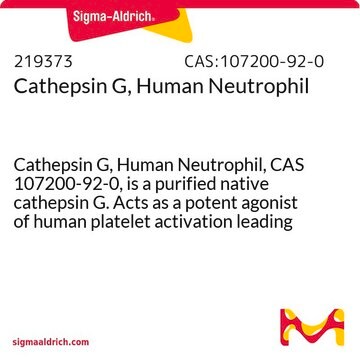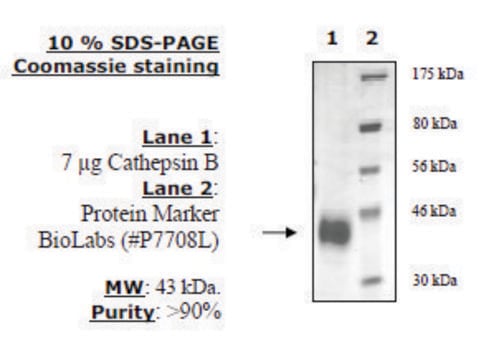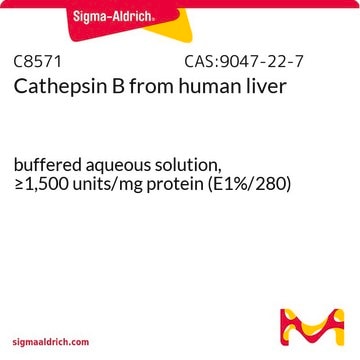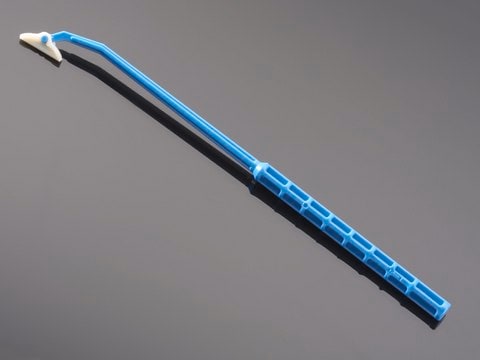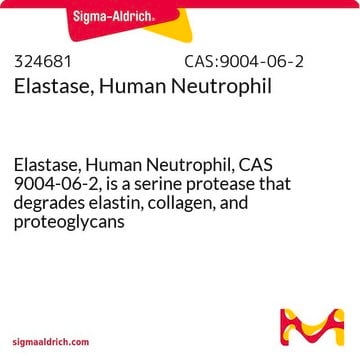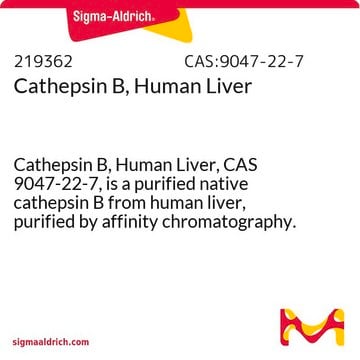SRP0290
Cathepsin F Active human
recombinant, expressed in FreeStyle™ 293-F cells, ≥90% (SDS-PAGE)
Sinonimo/i:
CATSF, CLN13
Autenticatiper visualizzare i prezzi riservati alla tua organizzazione & contrattuali
About This Item
Prodotti consigliati
Ricombinante
expressed in FreeStyle™ 293-F cells
Saggio
≥90% (SDS-PAGE)
Forma fisica
aqueous solution
Attività specifica
≥18 pmol/min-μg
PM
53 kDa
tecniche
activity assay: suitable
Solubilità
soluble
water: soluble
N° accesso NCBI
Condizioni di spedizione
dry ice
Temperatura di conservazione
−70°C
Informazioni sul gene
human ... CTSF(8722)
Descrizione generale
Research area: CELL SIGNALING
Human cathepsin F (GenBank Accession No. NM_003793), CD33 signal peptide(amino acids 1-16) + cathepsin S (amino acids 20-end), with C-terminal HIS tag, MW = 53 kDa (more than 58 kDa after post-modification), expressed in FreeStyle 293-F cells.
Human cathepsin F (GenBank Accession No. NM_003793), CD33 signal peptide(amino acids 1-16) + cathepsin S (amino acids 20-end), with C-terminal HIS tag, MW = 53 kDa (more than 58 kDa after post-modification), expressed in FreeStyle 293-F cells.
Applicazioni
Active human cathepsin F is useful for the study of enzyme kinetics, screening inhibitors, and selectivity profiling. Active human cathepsin F has been used in a study to assess its implications for the development of novel immunomodulators. Active human cathepsin F has also been used in a study to investigate microarray expression analysis and identification of serum biomarkers for Niemann-Pick disease.
Azioni biochim/fisiol
Cathepsin F (CtsF) are endopeptidases that play a role in lysosomal protein degradation. Beyond its involvement in protein recycling, CtsF has also been associated with immune responses mediated by Toll-like receptors (TLRs) and antigen processing. Additionally, mutation in the cathepsin F gene is related to the development of familial papillary thyroid cancer , type B Kufs disease, defective lysosomal degradation and abnormal autophagy, and Alzheimer′s disease.
Definizione di unità
One unit is defined as the amount of enzyme that will cleave 1 pmol of substrate per min at 37°C
Stato fisico
Formulated in 45 mM sodium acetate, 135 mM NaCl and 10% glycerol.
Nota sulla preparazione
Thaw on ice. Upon first thaw, briefly spin tube containing enzyme to recover full content of the tube. Aliquot enzyme into single use aliquots. Store remaining undiluted enzyme in aliquots at -70°C. Note: Enzyme is very sensitive to freeze/thaw cycles.
Note legali
FreeStyle is a trademark of Invitrogen Corp.
Codice della classe di stoccaggio
12 - Non Combustible Liquids
Classe di pericolosità dell'acqua (WGK)
WGK 1
Punto d’infiammabilità (°F)
Not applicable
Punto d’infiammabilità (°C)
Not applicable
Certificati d'analisi (COA)
Cerca il Certificati d'analisi (COA) digitando il numero di lotto/batch corrispondente. I numeri di lotto o di batch sono stampati sull'etichetta dei prodotti dopo la parola ‘Lotto’ o ‘Batch’.
Possiedi già questo prodotto?
I documenti relativi ai prodotti acquistati recentemente sono disponibili nell’Archivio dei documenti.
Salma Teimoori et al.
Parasitology international, 66(4), 443-447 (2016-05-04)
Diagnosis of Opisthorchis viverrini infection by conventional stool examination is increasingly difficult due to the low intensity of the infection after several rounds of control programmes in endemic regions as well as coinfections with intestinal flukes. Therefore sensitive and specific
The Crystal Structure of Human Cathepsin F and Its Implications for the Development of Novel Immunomodulators
Somoza JR, Palmer JT, Ho JD.
Journal of Molecular Biology, 322(3), 559-568 (2012)
Cathepsin F genetic mutation is associated with familial papillary thyroid cancer
Wang Y, et al.
Journal of Separation Science, 364(4), 414-424 (2022)
Cathepsins in the Pathophysiology of Mucopolysaccharidoses: New Perspectives for Therapy
Pasquale VD, et al.
Cells, 9(4), 979-979 (2020)
Celine V M Cluzeau et al.
Human molecular genetics, 21(16), 3632-3646 (2012-05-24)
Niemann-Pick disease type C (NPC) is a lysosomal storage disorder characterized by liver disease and progressive neurodegeneration. Deficiency of either NPC1 or NPC2 leads to the accumulation of cholesterol and glycosphingolipids in late endosomes and early lysosomes. In order to
Il team dei nostri ricercatori vanta grande esperienza in tutte le aree della ricerca quali Life Science, scienza dei materiali, sintesi chimica, cromatografia, discipline analitiche, ecc..
Contatta l'Assistenza Tecnica.